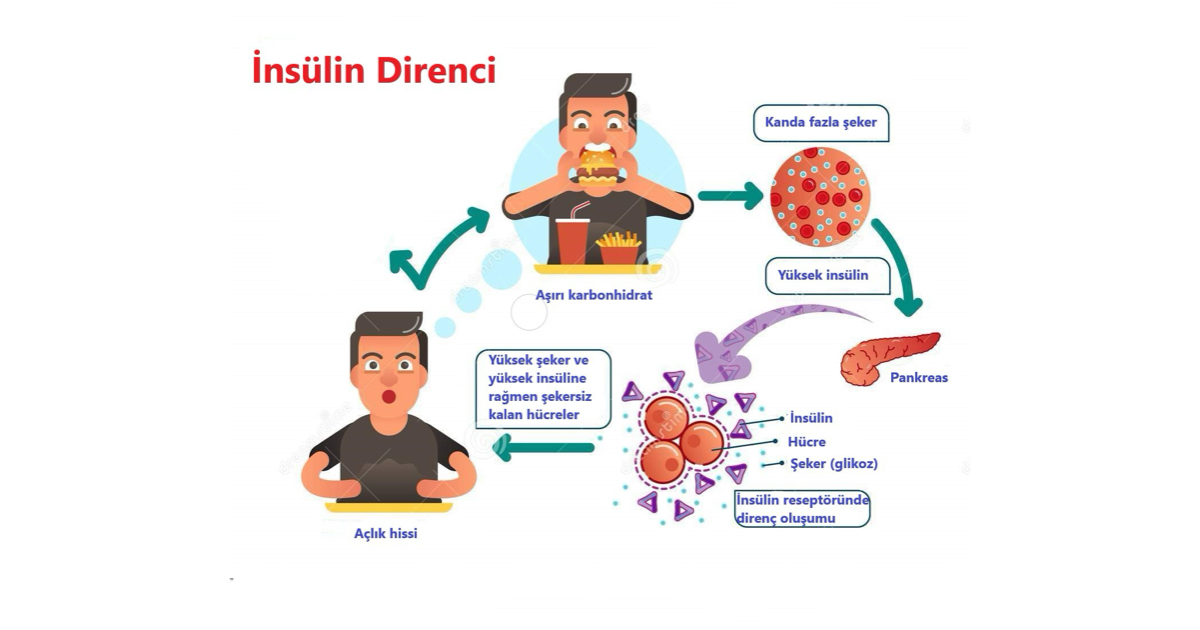İnsülin Direnci
What is Insulin Resistance?
Insulin is a hormone released from the pancreas that allows blood sugar to be used in tissues. In order for it to show its effect, there are receptors for insulin to bind to in the tissues that use sugar. The situation where these receptors become insensitive to insulin, and therefore insulin cannot show its effect even if it binds to this receptor, is called insulin resistance. Since insulin cannot show its effect, the tissues cannot use blood sugar and blood sugar begins to rise. In order to use blood sugar, the pancreas begins to secrete more insulin than normal and insulin levels gradually increase.

Who is it seen in?
It usually occurs after the age of 30 and usually after the age of 50. It is usually seen in people who are obese, sedentary and have an unhealthy diet of carbohydrates, gluten and refined products. Insulin resistance is not seen in primitive African natives who live in their natural habitats and have not been introduced to refined foods.
What are the symptoms?
If a person has complaints such as getting hungry easily, craving sweets, shaking hands and feet, cold sweats and feeling faint, feeling full late, not being able to lose weight despite dieting, gradually gaining weight, getting tired easily even with a little exercise, and if there are obese and diabetic people in their family, insulin resistance should be suspected. In addition, headache, sleep and psychological problems, allergic symptoms and rheumatic complaints are frequently seen.
How is it diagnosed?
Insulin resistance test is tested with HOMA Test. If there is insulin resistance in the blood sample taken in the morning after approximately 10-12 hours of fasting at night, an increase in insulin secretion occurs in order to keep the blood glucose level at normal levels. If the value in the HOMA test is 2.5 and above, it is evaluated in favor of insulin resistance. In addition to this test, insulin resistance can be diagnosed after tests such as AST, ALT, GGT, which will show blood sugar level, high insulin, liver steatosis, low HDL good cholesterol, high triglyceride, high uric acid.
In addition to laboratory findings, insulin resistance can also be detected with the Bioscan scanning device.
Why Can’t Those with Insulin Resistance Lose Weight?
Since the insulin level in their blood is much higher than normal, they cannot burn fat. Because insulin is a hormone that also prevents the breakdown of fat stores. In addition, these people have difficulty dieting because they get hungry very quickly, and they have difficulty exercising because they get tired very quickly, and they give up the diet in a short time.
What Other Diseases Does Insulin Resistance Trigger?
There are many studies that have found a relationship between high insulin resistance, insulin resistance, obesity and cancer. It has been observed in many scientific studies that it increases the risk of esophageal, colon, bile ducts, pancreas, breast, uterus, ovary, prostate, kidney, bladder, thyroid and lymph cancer. In addition, insulin resistance is guilty of many diseases such as diabetes, stroke, cardiovascular diseases, atherosclerosis, hypertension, fatty liver, high lipids, polycystic ovary disease and infertility. It has also been determined that there is a connection between Alzheimer’s (dementia) and insulin resistance.
Why Does It Happen?
In classical medicine, no clear reason is given as to why it happens. However, according to holistic medicine, the main reason for insulin resistance is intestinal flora disorder and candida. Candida is a microorganism that consumes sugar. When sugary foods reach the small intestine, the body is prepared to use the sugar that will pass into the blood by secreting insulin, but since candida consumes the sugar that comes to the intestine, the expected amount of sugar cannot pass into the blood. In this case, insulin cannot find enough sugar to use in the tissues. In this case, either the blood sugar will fall below the critical level for brain functions, which is incompatible with life, or the tissues will close their receptors to ignore insulin.
The second path, which is an adaptation path for life, is chosen and insulin resistance occurs. This is why almost all people with insulin resistance have a diet consisting of gluten, sugar and refined foods, do not exercise, and have common symptoms such as fatigue, weakness, psychological problems and allergies. (See the importance of intestinal flora) There is no person who is detected to have insulin resistance and whose intestinal flora is normal and who does not have candida.
How is it treated?
In order to correct insulin resistance, it is necessary to reverse the formation mechanisms. For this purpose, it is first necessary to switch to a natural diet away from gluten, sugar and refined foods. Probiotic-prebiotic supplements and replacement of missing vitamins and minerals are necessary. Rectal ozone application to repair the intestinal lining, bioresonance therapy to reduce food sensitivities and ensure compliance with a sugar-free diet, Neural therapy to reset intestinal disease memory, and to ensure blood circulation and lymphatic drainage must definitely be included in the treatment. In addition to these, sufficient water should be drunk and sufficient exercise should be done.
It is not possible to solve insulin resistance by dieting alone and using a few probiotic supplements.
Frequently Asked Questions
What is insulin resistance?
It is when the body’s cells do not respond properly to insulin, causing high blood sugar and extra insulin production.
What are the symptoms?
Frequent hunger, sugar cravings, fatigue, difficulty losing weight, headaches, sleep or mood problems.
How is it diagnosed?
Through a HOMA test, blood tests showing high insulin, low HDL, high triglycerides, and sometimes non-invasive devices like Bioscan.
Why is weight loss hard with insulin resistance?
High insulin prevents fat breakdown, increases hunger, and causes fatigue during exercise.
How is it treated?
Natural diet, probiotics, vitamins/minerals, gut therapies (ozone, neural therapy), regular exercise, and hydration.